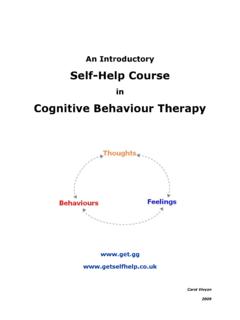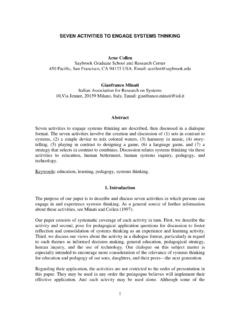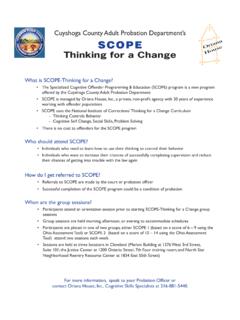Transcription of Lesson 2 Social Skill: Active Listening
1 Lesson 2 Social Skill: Active Listening Summary and Rationale Listening is a Social skill required for almost all interactions. It is also prerequisite to participating in a group process such as the thinking for a change Program. It helps establish norms and expectations about group participation. Concepts and Definitions Active Listening is the deliberate effort to hear and understand what others are saying. Objectives -As a result of this Lesson the group members will: 1. Describe the importance of Active Listening in this group and in other Social situations. 2. Perform the steps of Active Listening during the Lesson . 3. Perform the steps of Active Listening in real life situations. National Institute of Corrections Social Skill: Active Listening thinking for a change Lesson 2 - 1 Major Activities Activity 1: Overview of Social skills (in general) Activity 2: Overview of Social Skill: Active Listening Activity 3: Model the Skill Activity 4: Discuss Modeling Display Activity 5: Group Members Role Activity 6: Discuss Role Play Activity 7: Repeat Activities 5 and 6 with All Group Members Activity 8: Assign Homework Activity 9: Wrap Up Play Skill Supplements Charts Make before facilitating the Lesson .
2 (See the supplement section in each Lesson for full text of chart page.) Denoted in this symbol Lesson plan with Handouts -Make copies before the Lesson . (See the supplement section of each Lesson for camera-ready pages.) Denoted in Lesson plan with this symbol H-2-1-Pocket Skill Cards H-2-2-Homework Sheet Power Point Slides -Make transparencies if a presentation projector is not available. (See the supplement section of each Lesson for camera-ready pages.) Denoted in Lesson plan with this symbol P-2-1- Social skills Overview P-2-2 Social skills Definition P-2-3 Process for the Social Skill Lessons P-2-4- Lesson Title P-2-5 Active Listening Definition P-2-6 Active Listening Skill Steps National Institute of Corrections Social Skill: Active Listening thinking for a change Lesson 2 - 2 Equipment Supplies Easel (chart stand) Chart Paper Projector to Show Presentation Slides Markers Projection Screen or Suitable Surface Masking Tape Copies of Handouts References Aggression Replacement Training: A Comprehensive Intervention for Aggressive Youth.
3 Third Edition: Revised and Expanded. Glick, B. and JC Gibbs. 2011. Champaign, IL: Research Press. Skillstreaming the Adolescent (Revised Edition): Goldstein, AP and McGinnis, Champaign IL: Research Press. National Institute of Corrections Social Skill: Active Listening thinking for a change Lesson 2 - 3 Social skills :Overview Content Activity 1: Overview of All Social skills Beginning with this session, we are going to identify and practice a way to learn and use techniques to better get along with others, both individually and in small groups. We will use these techniques to learn a set of specific skills called Social skills . Let s define skills . What does that mean? Notes P-2-1 Write all group responses on chart paper. Reinforce those that support the definition of Social skills . (Answers that reflect that skills are things we do.) The discussion gives group members a chance to talk about some of the skills they have, helping them make a link between a Social skill and something like fixing a carburetor.
4 National Institute of Corrections Social Skill: Active Listening thinking for a change Lesson 2 - 4 2 Social skills Social skills are the skills we use when we deal with other people Good Social skills help get us what we want; maximizing positive responses, and minimizing negative responses from other people 3 Process for the Lesson1. Homework review2. Learn next Social skill Facilitator introduces and models new skill Group members role play new skill and receive performance feedback3. Transfer of training Contract to practicenew skill Content Notes skills are abilities that help us reach a goal. skills can be learned. Just like we talked about in the first Lesson we will fill our pockets up with skills we can use to reach our goals. This is the definition of Social skills that we ll use throughout this program: Social skills are the skills we use when we deal with other people.
5 Good Social skills usually get us what we want; maximizing positive responses, and minimizing negative responses from other people. That is not surprising since we know and use Social skills on a daily basis. Process to be used for each Social Skill Lesson Here is what you can expect in each Social skill Lesson presented in this program. 1. Homework Review Each Social skill Lesson will start with a review of the last Lesson s homework -P-2-2 P-2-3 National Institute of Corrections Social Skill: Active Listening thinking for a change Lesson 2 - 5 Content Notes which will be done outside of class using the skill you learned. 1. Learn Next Social Skill I will introduce the new skill. My co-facilitator and I will model this skill using the exact steps we want you to follow. You will role-play the steps of the skill in a current personal situation you identify.
6 The group members will give you feedback about how you did in following the steps of the skill. 2. Transfer Training You will contract to practice the skill outside the group, in a real life situation, between now and the next session. Practice New Skill After each Lesson , you will practice the skill you have learned in as many real life situations as possible. What questions do you have about the steps you will use for each session? National Institute of Corrections Social Skill: Active Listening thinking for a change Lesson 2 - 6 Social SkillActive Listening An Active way of hearing what the other person is saying to youActive Listening -Definition5 Content Notes Let s get started on our Social skill for today: Active Listening . Activity 2: Overview of Social Skill: P-2-4 Active Listening Today we will talk about a skill that is often taken for granted, Active Listening .
7 Define the Skill P-2-5 What does Active Listening mean to you? (Answer: Active Listening is an Active way of hearing what the other person is saying to you.) We will talk more about what Active Listening means to you in a little bit, but right now we are going to review the skill steps. Then _____ and I will do a brief vignette that shows you the steps of the skill, Active Listening . After you have had a chance to watch us model this, we will talk about times when you may have to or want to use the skill in the National Institute of Corrections Social Skill: Active Listening thinking for a change Lesson 2 - 7 Content near future. Then you will have a chance to try it out. Skill Steps Action and thinking Every skill is made up of a number of steps. Each of the steps is either a thinking step or an action step. A thinking step is something that we say to ourselves; it cannot be seen.
8 In our sessions, when we do a thinking step, we point to our head to show group members that what we are saying is to ourselves, and is going on inside our head. As we point to our head, we say the words (the thoughts in our head) aloud so everyone can hear them. The second type of step is an action step. It is called that because others can see the person doing that skill step. Skill Step Identification Step 1 is, Look at the person who is talking. Is that a thinking step or an action step? (Answer: It is an action step because you can see where someone is looking.) Step 2 is, Think about what is being said Is that a thinking step or an action step? (Answer: It is a thinking step.) Notes 6 Active Listening1. Look at the person who is talking 2. Think about what is being said3. Wait your turn to talk4. Say what you want to say P-2-6 You and the group members should read the National Institute of Corrections Social Skill: Active Listening thinking for a change Lesson 2 - 8 Content Notes Step 3 is, Wait your turn to talk.
9 Which type of step is that thinking or action? (Answer: It is an action step, as you can see someone waiting.) Step 4 is, Say what you want to say. Is that a thinking step or an action step? (Answer: It is an action step. You can observe someone saying something.) What questions do you have about the steps of the skill, Active Listening ? Hand Out Pocket Skill Cards Here is a card that lists the steps of the skill. You will use it later to help when practicing the skill (during the session and in real life situations). Activity 3: Model the skill Active Listening Now _____ and I will model the skill for you. Modeling Display Option #1 For institutional settings, adult or youth: I am a member of a group, and _____ steps of the skill (rather than just saying step 1 or step 2. ) Repeating the entire step at every opportunity will reinforce learning. Thank each contributing group member and provide positive feedback for participation. H-2-1 Pocket Skill Cards, Active Listening The purpose of a modeling display is to demonstrate the steps of the skill.
10 Use one of the three options suggested in the Lesson plan to make sure that you do that correctly. Select the situation which applies to your group National Institute of Corrections Social Skill: Active Listening thinking for a change Lesson 2 - 9 Content Notes is telling a story about a situation that setting; Youth, adult, happened in the cafeteria where he/she saw a community, or kitchen worker drop a serving spoon onto the incarceration. floor then pick it up and put it back in the food. It may be appropriate to change some details of the Modeling Display Option #2 Probation or situation to meet the parole settings: circumstances of your I am meeting with my for the first time. He is instructing me about the conditions of my release (or of probation) and I audience but the core elements should stay the same. have to listen carefully to know when my Tell group members which curfew is and how far I can travel from home facilitator is the main without being in violation of my actor, modeling the skill.









